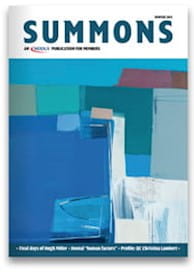MANY people will be familiar with the comparisons that have been made between the world of aviation and healthcare, especially for anaesthetists and the operating theatre, but could the analogy also be applied to dentistry? Here the typical scenario is based around two people, a shared task, a difference in skill sets between them, with one clearly leading and being held responsible and the other supporting.
Consider the following real-life example
Shortly after midnight on January 3, 2004 a Flash Air aircraft took off from Sharm-el- Sheikh for the 50 minute journey to Cairo. The night was clear and cloudless. The departure routing required a southwesterly take-off followed by a very long left hand turn to track north-westward towards Cairo. As the turn progressed and the limited lights around Sharm were replaced by the blackness of the Red Sea and featureless desert the pilot became disorientated and he started to lose control of the aircraft with an ever increasing bank angle. The other pilot was aware of the deteriorating situation but seemed inhibited in his response. In fact the worse the situation became the less he contributed. The aircraft crashed seven miles south of the airport killing all on board.
A one-off or part of a pattern? In 1999 the crew of a Korean cargo aircraft taking off from Stansted became disorientated and crashed. Two Kenya Airways aircraft crashed for similar reasons in 2000 and 2007, as did one from Ethiopian Airlines in 2010.
To air safety professionals, what is particularly interesting in these incidents is that in every one the most experienced pilot was flying the aircraft at the time. The captains lost control of the situation and the cockpit voice recorders suggest that the co-pilots were aware of the divergence from a safe condition but failed to either express their concern or intervene effectively.
Statistics show that worldwide captains operate flight controls for about 60 per cent of the time but they operate the controls in 90 per cent of accidents that feature the catastrophic loss of control seen in our examples above.
In Western Europe/North America we would like to be smug and say that it couldn’t happen with our standard procedures and crew dynamics built around Crew (team) Resource Management best practice, but life doesn’t come with guarantees. The best we can do is to stack the odds in favour of success.
We train to understand and apply best human factors practice and two areas are highlighted in the accidents that I have described.
Thinking and doing
The first is what we call a Think/Do conflict. In essence our grey matter has to exercise control over motor functions (the “do” bit) while undertaking sense making and cognitive processing (thinking) using a shared resource. Most of the time we don’t notice the conflict because we have only moderate demands from either source and lack an objective measure of performance for either function.
There are lots of opportunities to see the conflict in action if we can use speech as a proxy for cognitive effort. Conversation stops when manoeuvring into a parking space. Drivers find themselves in the wrong lane at a junction or roundabout because they were using an approved hands-free telephone as they approached – their hands may be free but their brain is tied up.
If you are still unconvinced try this little exercise.
1. Take a tennis or cricket-sized ball and throw and catch it repeatedly aiming for a consistent height of about 1.5 metres. This is motor function and as repetitive activity should become easier with practice.
2. Hold the ball and recite the alphabet from A to Z out loud. This is cognitive activity in that you are retrieving information from memory, and speaking it out loud is a proxy for the effort involved.
3. Try to do both at the same time. Depending on your skill at catching and your fluency with alphabet recollection you may be able to do both with reasonable aplomb but my guess is that the catching becomes erratic and the alphabet more laboured because it is the sum of the two demands that matters.
4. Now explore overload. Repeat the ball catching and alphabet recitation together but this time recite the alphabet backwards from Z to A. Watch and listen to the resulting performance. When the sum of the two demands exceeds your capacity both functions will be affected. You will become incompetent (make unforced errors in the ball catching) AND your judgement will be compromised (in this exercise you may retrieve and utter information poorly).
In aviation the best practice is to divide thinking and doing between the pilots such that one pilot handles the aircraft and autopilot to control the flight-path (doing) and the other exercises overall control but metaphorically sits on their hands (thinking). This is in stark contrast to the old ways of a “one man band” operation where the ability to cope with the combined workload played to the ego but resulted in very fragile performance as we have seen. If there is only a single pilot present we separate the demands temporally by doing as much thinking as possible before the activity starts or reducing activity to allow deeper thought.
Are there parts of your job as a dentist where the Think/Do conflict poses a risk to clinical care? Can you think of ways to spread the load within your team to mitigate that risk? Communicating effectively when the workload is high is critical to safety, but creating the appropriate environment in which the communication can take place has to be undertaken before the workload increases. This relates to the second challenge – the so-called authority gradient within a team.
Authority gradient
Addressing the issue of a fellow professional failing to raise their concerns effectively is an important concern in any safety critical activity. Folk wisdom has it that the onlooker sees more of the game and it does not require a great leap of the imagination to propose that appropriately trained colleagues with low activity demands will be able to make good sense of unfolding events.
Whether they share information or voice concerns is influenced by what we refer to as the authority gradient. This represents the difference in power between the parties. Sources of power can be knowledge, confidence, strength of character or personality or result from position or role. Culture in Australia and North America can be characterised as having shallow authority gradients exemplified by high challenge coupled with high respect. Many Asian cultures have steep gradients. Individuals display deference to authority or are unwilling to express their opinion for fear of causing upset or losing face if they are wrong.
In practice the authority gradient is a perception of the instantaneous power difference between two people and shifts according to circumstance. In aviation we encourage a shallow gradient by sharing information, inviting comment, agreeing vocabulary to be used when raising concerns and being explicit about roles and expectations. Clearly there is an option to “pull rank” in a crisis and a steep gradient may be used as a short intervention.
Consider the authority gradient in your practice. Do your team members feel empowered to speak up with any concerns? Creating an open environment in which healthcare staff feel confident to express concerns could provide an important safety net. Safety is not a single event or even something that we “do”.
Safety is a notion which should inform our every action. Both medicine and dentistry can draw valuable insights from the long experience of the aviation industry in managing human factors. It requires that practice teams – no matter how small – consider their unique work environment and mould these principles to fit.
Phil Higton is director of training with healthcare training firm Terema
This page was correct at the time of publication. Any guidance is intended as general guidance for members only. If you are a member and need specific advice relating to your own circumstances, please contact one of our advisers.
Read more from this issue of Insight

Save this article
Save this article to a list of favourite articles which members can access in their account.
Save to library
